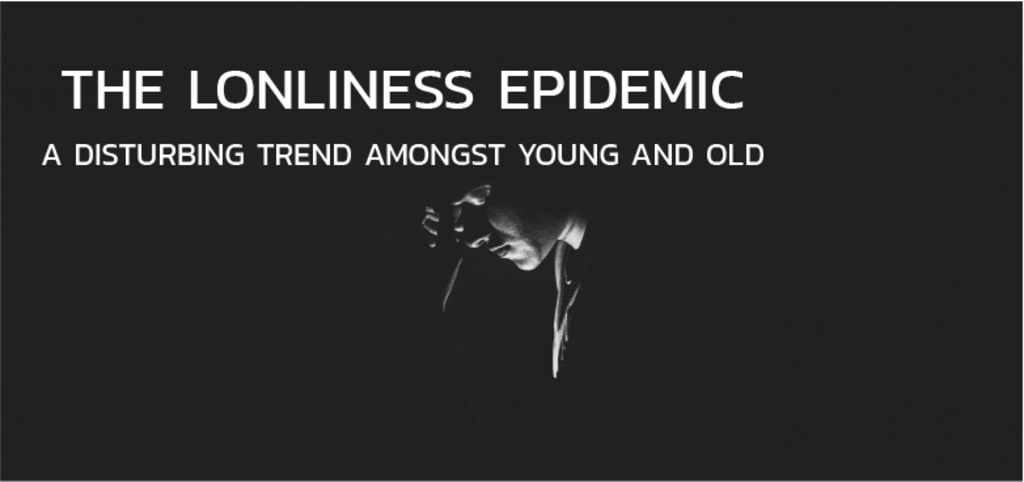The loneliness Epidemic a Disturbing Trend Amongst Young and Old
4 types of loneliness and why knowing them can save a life

Loneliness is a subjective, unwelcome feeling of lack or loss of companionship, which happens when there is a mismatch between the quantity and quality of the social relationships that we have, and those that we want (Perlman and Peplau, 1981)
Loneliness can be defined as a distressing emotional state stemming from a perceived deficiency in social connections and intimacy. It is essential to differentiate between social isolation (lack of social contact) and loneliness (an emotional response to isolation).
Traditionally Contributing factors to loneliness included situational variables such as physical isolation, moving to a new location, and divorce. The death of someone significant in a person’s life can also lead to feelings of loneliness. Loneliness is also attributed to internal factors such as low self-esteem.
In the past two decades, social media has undeniably transformed the way we communicate and interact with others. While it has brought about numerous benefits, it is imperative to acknowledge the negative impacts that this technological advancement has had on human behavior and social interactions.
In the past, maintaining strong relationships required sincere effort and face-to-face interactions. However, the ease of online communication has made it effortless to connect with others, albeit superficially. Social media platforms emphasize quantity over quality, with users focusing on accumulating virtual friends and followers rather than nurturing deep connections. As a result, genuine interpersonal relationships have taken a backseat, leading to a deterioration in the overall quality of relationships.
Researchers employ various methods, such as self-report questionnaires and interviews, to assess individuals’ subjective experiences. These measures allow for statistical analysis and comparisons across different demographics.
Loneliness transcends national boundaries, but certain countries exhibit higher prevalence rates. According to recent studies, countries such as Japan, South Korea, the United States, the United Kingdom, and Australia have shown higher rates of loneliness in their populations.
Young adults and adolescents are particularly susceptible to loneliness due to numerous social and developmental factors. The transition to adulthood, increased reliance on digital communication, and shifting societal norms contribute to feelings of disconnection. Studies reveal that individuals aged 18–25 often report higher levels of loneliness compared to older age groups.
While there are many factors that determine how we react to loneliness we should not ignore the negative impact it can have on society. An analysis of the psychological crises exhibited by 177 mass shooters has identified social isolation as the most important external indicator leading up to the attacks. The finding, which is based on research conducted at Virginia Commonwealth University, suggests that social isolation is an ideal candidate for acquaintances and communities of would-be shooters to intervene.
“When we are isolated from our social circles, we lose that functional component of our loved ones being frank with us when our behavior might become inappropriate,” said Samuel West, Ph.D., an assistant professor of psychology at Virginia State University who led the study while he was a postdoctoral researcher at the Injury and Violence Prevention Research Lab at VCU Health.
“Although most people who experience isolation do not go on to commit such acts of violence, intervening in that isolation only holds benefits for the individual,” West said. “This can be as simple as a friend stopping by in person to say hello and catch up — something that we could all benefit from.
Psychologists have recognized four different types of loneliness: emotional, social, situational, and chronic.
Emotional Loneliness:
Emotional loneliness refers to the feeling of being disconnected or isolated from others on an emotional level. It occurs when individuals perceive a lack of meaningful and intimate relationships in their lives. People experiencing emotional loneliness may have a longing for deep emotional connections and intimacy. They may feel a sense of emptiness, or a void despite being surrounded by others. This type of loneliness often arises when individuals lack close friendships or romantic partnerships that provide emotional support and understanding.
Social Loneliness:
Social loneliness is characterized by a sense of isolation resulting from a limited number or absence of social interactions and relationships. It occurs when individuals feel disconnected from their social networks, such as friends, colleagues, or community groups. People experiencing social loneliness may feel a lack of companionship, involvement, or belongingness. This kind of loneliness may be influenced by things like moving, losing friends, or having trouble making new connections.
Situational Loneliness:
Situational loneliness is related to specific circumstances or temporary situations that cause individuals to feel alone. It can occur when someone is physically separated from others due to various reasons, such as being away from family or friends, being in a new environment, or going through a life transition. Situational loneliness is often short-term and can be alleviated once the situation changes or individuals establish new connections. Examples of situations that may lead to situational loneliness include starting college, moving to a new city, or going through a breakup.
Chronic Loneliness:
Chronic loneliness refers to a persistent and long-lasting feeling of being alone, even when surrounded by others. It is characterized by a deep sense of isolation, disconnection, and dissatisfaction with social relationships. Individuals experiencing chronic loneliness may feel a pervasive sense of emptiness, irrespective of their social interactions or relationships. This type of loneliness often stems from internal factors, such as low self-esteem, social anxiety, or difficulties in forming meaningful connections. Chronic loneliness can have adverse effects on mental and physical well-being and may require professional support to be addressed.
It’s important to remember that different kinds of loneliness are not mutually exclusive, and people can experience many at once. As a result of variables like personality, living circumstances, and social support networks, the experience and perception of loneliness can differ widely from person to person.
What are the effects of loneliness?
Research has linked social isolation and loneliness to higher risks for a variety of physical and mental conditions: high blood pressure, heart disease, obesity, a weakened immune system, anxiety, depression, cognitive decline, Alzheimer’s disease, and even death. Chronic loneliness has also been linked to an increased risk of depression, dementia, self-harm, and suicide. Research finds that the link between loneliness and mental illnesses such as depression and anxiety is bidirectional.
Conclusion:
While there are several factors that have contributed to the trends we are seeing in our daily interactions with each other, there is both a positive and negative shift happening, and it is crucial to recognize the impacts it is having on us as individuals, families, communities, and society as a whole. The rise of isolation, diminished quality of relationships, negative effects on self-esteem, decline in empathy and authenticity, and reduced productivity are all consequences of “social advancement,” and learning to strike balance in our lives is essential to mitigate these adverse effects and foster healthier, more meaningful human connections. If I had to summarize a possible solution for what we are seeing, I would say “We need to care a little harder”.
Conversation can be a tool for personal growth and self-discovery. When we share personal information about ourselves with others, we are forced to confront our own thoughts and feelings in a way that we may not have done otherwise. This can lead to greater self-awareness and insight into our own behavior and motivations. Additionally, when we receive feedback or advice from someone we trust, we may be able to see our own blind spots or patterns of behavior that we were previously unaware of. This can be particularly helpful for those who are seeking to make changes in their lives or work through past traumas or experiences.
Thanks for your time.
About the Creator
House of Holistic
Understanding that all parts are interconnected and can be explained only by reference to the whole. As a student of life I'm sharing what I learn. We all have more in common than we think, I aim to lift the barrier that keeps us strangers






Comments
There are no comments for this story
Be the first to respond and start the conversation.